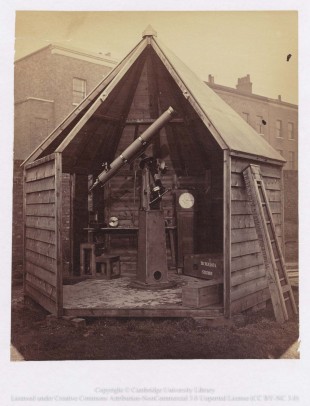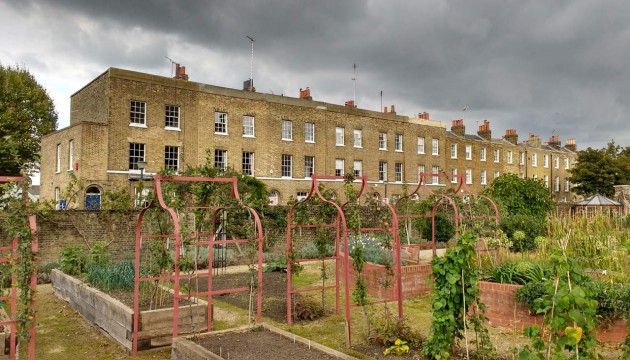…where east meets west
- Home
- Brief History
- The Greenwich Meridian
- Greenwich
(1675–1958) - Herstmonceux
(1948–1990) - Cambridge
(1990–1998) - Outstations (1822–1971)…
- – Chingford (1822–1924)
- – Deal
(1864–1927) - – Abinger
(1923–1957) - – Bristol & Bradford on Avon
(1939–1948) - – Bath
(1939–1949) - – Hartland
(1955–1967) - – Cape of Good Hope
(1959–1971)
- Administration…
- – Funding
- – Governance
- – Inventories
- – Pay
- – Regulations
- – Royal Warrants
- Contemporary Accounts
- People
- Publications
- Science
- Technology
- Telescopes
- Chronometers
- Clocks & Time
- Board of Longitude
- Libraries & Archives
- Visit
- Search
The ‘Reserve(d) Ground’ of Greenwich Park

One of the Transit of Venus huts in the Reserve Ground. Probably taken in 1873 or 1874, the image shows one of the equatorials with No.12 Park Vista behind it to the left. Prior to the photograph being taken, the front panels of the hut were temporarily removed so that the telescope and clock could be seen inside. Reproduced under the terms of a Creative Commons Attribution-Non-Commercial (CC BY-NC) licence courtesy of Cambridge Digital Library (see below)
In the run up to the Transit of Venus, numerous huts were constructed at the Royal Observatory to house the observing instruments during the Transit. As they were completed, they were erected in the South Ground for instrument trialling prior to shipping.
By the middle of 1872, the Observatory was beginning to run short on space. Airy therefore arranged with the First Commissioner of Her Majesty’s Works and Parks for the Reserve Ground of Greenwich Park to be temporarily used for the overflow. On 20 September, while Airy was on leave, Archibald McIntyre, the Superintendent of Greenwich Park, called at the Observatory to ascertain the area required in the park and the time the huts would probably remain there (RGO6/784).
In his journal (RGO6/59/1 & RGO6/59/2), George Tupman, (whom Airy had put in charge of coordinating the expedition), variously refers to the Reserve Ground as Maze Hill, the vicarage garden or ground and the vicarage. He also records that huts were set up in the Wilderness, (the enclosed area in the south-east corner of the Park that is now the deer enclosure), the Royal Naval College and at Chatham.
Eight of the observing huts had been transferred to the Reserve Ground by 22 May 1873, with several more after that. By 20 May 1874, all the huts bar those destined for Egypt had been taken down ready for shipment. On their return from overseas, many of the huts were stored in the Reserve Ground until at least 1879.

The Queen's Orchard from roughly the same viewpoint in October 2016. The house on the left (12 Park Vista) is on the corner of Greenwich Park Street. It, together with the four house to its immediate right, suffered significant structural damage in the Second World War
Image licensing
The image (above right) of the Transit of Venus hut in the Reserve Ground is reproduced in compressed and slightly cropped form under the terms of a Creative Commons Attribution-NonCommercial 3.0 Unported License courtesy of Cambridge Digital Library (RGO6/276).
© 2014 – 2026 Graham Dolan
Except where indicated, all text and images are the copyright of Graham Dolan